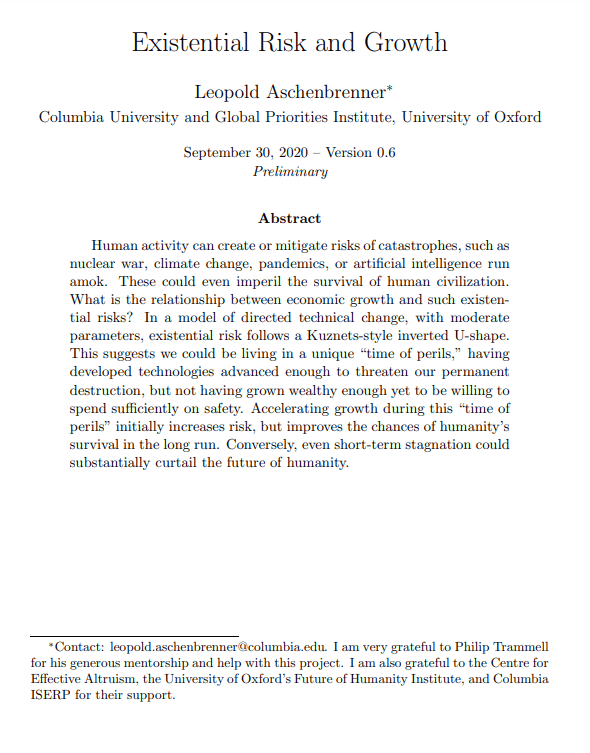The Risks of Stagnation (Article for Works in Progress)
Human activity and new technologies can be dangerous, threatening the very survival of humanity. Does that mean economic growth is inherently risky?
I wrote an article for the second issue of Works in Progress magazine. You can read it here:
Securing posterity - Works in Progress
New technologies can be dangerous, threatening the very survival of humanity. Is economic growth inherently risky, and how do we maximize the chances of a flourishing future?

This work is based on my paper on existential risk and economic growth:
Existential risk and growth - Leopold Aschenbrenner (Columbia University) - Global Priorities Institute
Human activity can create or mitigate risks of catastrophes, such as nuclear war, climate change, pandemics, or artificial intelligence run amok. These could even imperil the survival of human civilization. What is the relationship between economic growth and such existential risks? In a model of di…

(Covered on Marginal Revolution here and here.)
"It is not safe stagnation and risky growth that we must choose between; rather, it is stagnation that is risky and it is growth that leads to safety."@leopoldasch summarized his famous paper in a very readable essay https://t.co/LToaGwRLAE
— Max Roser (@MaxCRoser) July 6, 2021
An excerpt from the Works in Progress article below:
In the decades since, the risks from human activity have multiplied. While the median climate change scenario would merely be unpleasant, there is the possibility of tail-end scenarios that could end civilization as we know it. Advances in biotechnology might allow us to engineer a new pathogen that silently spreads before killing not just millions, but all of humanity. Some, like Elon Musk, fear that we might soon develop artificial intelligence that could go rogue.
The same technological progress that creates these risks is also what drives economic growth. Does that mean economic growth is inherently risky? Economic growth has brought about extraordinary prosperity. But for the sake of posterity, must we choose safe stagnation instead? This view is arguably becoming ever-more popular, particularly amongst those concerned about climate change; Greta Thunberg recently denounced “fairy tales of eternal economic growth” at the United Nations.
I argue that the opposite is the case. It is not safe stagnation and risky growth that we must choose between; rather, it is stagnation that is risky and it is growth that leads to safety.
We might indeed be in “time of perils”: we might be advanced enough to have developed the means for our destruction, but not advanced enough to care sufficiently about safety. But stagnation does not solve the problem: we would simply stagnate at this high level of risk. Eventually, a nuclear war or environmental catastrophe would doom humanity regardless.
Faster economic growth could initially increase risk, as feared. But it will also help us get past this time of perils more quickly. When people are poor, they can’t focus on much beyond ensuring their own livelihoods. But as people grow richer, they start caring more about things like the environment and protecting against risks to life. And so, as economic growth makes people richer, they will invest more in safety, protecting against existential catastrophes. As technological innovation and our growing wealth has allowed us to conquer past threats to human life like smallpox, so can faster economic growth, in the long run, increase the overall chances of humanity’s survival.
Read the full article here.
FOR OUR POSTERITY Newsletter
Join the newsletter to receive the latest updates in your inbox.


